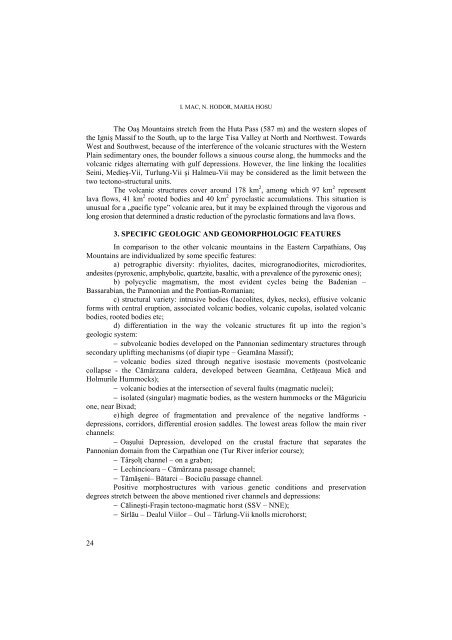geographia - Studia
geographia - Studia
geographia - Studia
You also want an ePaper? Increase the reach of your titles
YUMPU automatically turns print PDFs into web optimized ePapers that Google loves.
I. MAC, N. HODOR, MARIA HOSU<br />
The Oaş Mountains stretch from the Huta Pass (587 m) and the western slopes of<br />
the Igniş Massif to the South, up to the large Tisa Valley at North and Northwest. Towards<br />
West and Southwest, because of the interference of the volcanic structures with the Western<br />
Plain sedimentary ones, the bounder follows a sinuous course along, the hummocks and the<br />
volcanic ridges alternating with gulf depressions. However, the line linking the localities<br />
Seini, Medieş-Vii, Turlung-Vii şi Halmeu-Vii may be considered as the limit between the<br />
two tectono-structural units.<br />
The volcanic structures cover around 178 km 2 , among which 97 km 2 represent<br />
lava flows, 41 km 2 rooted bodies and 40 km 2 pyroclastic accumulations. This situation is<br />
unusual for a „pacific type” volcanic area, but it may be explained through the vigorous and<br />
long erosion that determined a drastic reduction of the pyroclastic formations and lava flows.<br />
3. SPECIFIC GEOLOGIC AND GEOMORPHOLOGIC FEATURES<br />
In comparison to the other volcanic mountains in the Eastern Carpathians, Oaş<br />
Mountains are individualized by some specific features:<br />
a) petrographic diversity: rhyiolites, dacites, microgranodiorites, microdiorites,<br />
andesites (pyroxenic, amphybolic, quartzite, basaltic, with a prevalence of the pyroxenic ones);<br />
b) polycyclic magmatism, the most evident cycles being the Badenian –<br />
Bassarabian, the Pannonian and the Pontian-Romanian;<br />
c) structural variety: intrusive bodies (laccolites, dykes, necks), effusive volcanic<br />
forms with central eruption, associated volcanic bodies, volcanic cupolas, isolated volcanic<br />
bodies, rooted bodies etc;<br />
d) differentiation in the way the volcanic structures fit up into the region’s<br />
geologic system:<br />
− subvolcanic bodies developed on the Pannonian sedimentary structures through<br />
secondary uplifting mechanisms (of diapir type – Geamăna Massif);<br />
− volcanic bodies sized through negative isostasic movements (postvolcanic<br />
collapse - the Cămârzana caldera, developed between Geamăna, CetăŃeaua Mică and<br />
Holmurile Hummocks);<br />
− volcanic bodies at the intersection of several faults (magmatic nuclei);<br />
− isolated (singular) magmatic bodies, as the western hummocks or the Măguriciu<br />
one, near Bixad;<br />
e) high degree of fragmentation and prevalence of the negative landforms -<br />
depressions, corridors, differential erosion saddles. The lowest areas follow the main river<br />
channels:<br />
− Oaşului Depression, developed on the crustal fracture that separates the<br />
Pannonian domain from the Carpathian one (Tur River inferior course);<br />
− TârşolŃ channel – on a graben;<br />
− Lechincioara – Cămârzana passage channel;<br />
− Tămăşeni– Bătarci – Bocicău passage channel.<br />
Positive morphostructures with various genetic conditions and preservation<br />
degrees stretch between the above mentioned river channels and depressions:<br />
− Călineşti-Fraşin tectono-magmatic horst (SSV – NNE);<br />
− Sirlău – Dealul Viilor – Oul – Târlung-Vii knolls microhorst;<br />
24

















